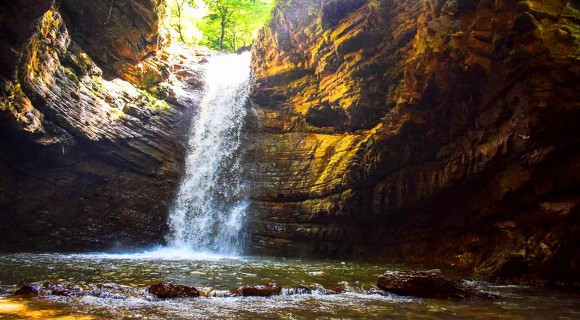Arge Bam in the Kerman province

The largest adobe structure in the world is called the Arg-e Bam, and it is situated in the city of Bam in the Kerman Province of southeast Iran.
The entire structure was once a sizable stronghold that contained the citadel; however, as the citadel presently dominates the remains, the fortress as a whole is now known as Bam Citadel.
It dates at least to the Achaemenid Empire and is included in the UNESCO World Heritage Site "Bam and its Cultural Landscape" (sixth to fourth centuries BC).
From the seventh through the eleventh centuries, the citadel gained prominence as a crossroads along the Silk Road and other significant commerce routes and as a manufacturer of silk and cotton clothing.
The citadel, along with a large portion of the remainder of Bam and its surroundings, was nearly completely devastated by an earthquake on December 26, 2003. Iran's president, Mohammad Khatami, declared that the citadel would be reconstructed a few days after the earthquake.
a quick background

The structures that make up the Bam Citadel have no exact archaeological dates. The fort constructed by the Achaemenians, approximately 579–323 BC, can be identified as the first human settlement in the region by historical evidence and ancient writings.
Archaeologists have likened some of the citadel's characteristics to the Achaemenian design of Persepolis, such as its placement on a platform made up of a natural hilltop and a man-built terrace.
The fort was extended during the Parthian era to become Arg-e-Bam, the Citadel of Bam.
According to a comparison study titled "Bam and a Brief History of Urban Settlement and Planning in Iran," the main portion of the city of Bam and the governor's portion were built during the Parthian era.
The castle was taken during the Sassanid era by Ardeshir Babakan.
Arg-e-Bam most likely sustained destruction during the Arab conquest of the Kerman region in 645 AD.
One of the first mosques to be built in Iran during the early Islamic era was the Al Rasoul mosque, which was founded by an Arab commander.
Ali's Muslim adversaries, the Khawarij, fled to Kerman and Bam in 656 AD, where they eventually made their home in the Arg-e-Bam. Ya'qub ibn al-Layth al-Saffar, who was battling the Abbasids in 869 AD, overcame the Khawarij and seized control of Arg-e-Bam.
Then, it became his constant base of operations. In the 10th century, Islamic writers first make reference to the name Bam.
These sources claim that Bam was once a developed marketplace encircled by a sizable agricultural region.
The city was renowned for its fashionable cotton garments, crowded bazaars, and palm palms in addition to its purportedly indestructible fortification.
Bam and the Kerman region were given to the Qarakhataian dynasty during the Mongol conquest of Iran, and they ruled the area from 1240 until 1363 AD. Bam reaped the benefits of its advantageous location along the spice trade, which linked the area to the Silk Road. The city had a thriving silk industry and was known for producing silkworms.

From 1502 to 1722, Iran experienced a time of comparatively quiet and stability under the Safavid dynasty.
Both Arg-e-Bam and the rest of the nation had advanced greatly. During this time, the Four Seasons Palace was constructed.
Agha Mohammad Khan, the founder of the Qajar dynasty, took control of Arg-e-Bam toward the end of the Safavid era.
He turned the citadel into a military complex by using it as a strategic vantage point to repel Afghan and Baluchi incursions.
When Prince Firooz Mirza, later known as Farman Farma (the Ruler of Rulers), who would later become known as the Nizari Ismaili sect's Aga Khan I, rebelled against Mohammad Shah Qajar in 1839, he sought refuge in Arg-e-Bam.
People began to settle outside the walls of the ramparts as a result of the expanding military presence inside Arg-e-walls. Bam's Firooz Mirza suggested in an article from 1880 that the old, abandoned city at the base of the citadel be destroyed and the area turned into a garden because only military personnel were living there.
The old Bam was gradually abandoned as the modern city of Bam was being built starting in 1900.
Up until 1932, the citadel served as a fortress; however, after that year, both the garrison and the ancient city were abandoned.
The site was gradually conserved and restored after it was designated as a nationally significant historic site in 1953, but the majority of the work was done from 1973 onward.
Arg-e-Bam was given to the Cultural Heritage Organization of Iran following the Islamic Revolution (ICHO).
The citadel was named one of the Cultural Heritage Organization's most important projects in 1993.
Arg-e Bam's various components

Investigations into the Arg-e Bam's structure show that the architects of this edifice had a well-thought-out plan from the start for building this citadel.
The castle is in the ideal spot for keeping an eye on the military and defense.
The Government Section and Residential Section are the two main sections of Arg-e Bam.
The military fortress, the four-season mansion, the barracks, the 40-meter water well, and the stables with room for 200 horses are all located in the government sector, which is in the center of Arg-e Bam.
There are more than 400 homes in the residential area, along with public buildings like schools and sports facilities.
In Arg-e Bam, there are three different kinds of homes. For poor families, small houses with a couple of rooms.
The most opulent homes, with more rooms, are spread out throughout the city, with a large yard and a nearby stable for animals.
These homes are larger, with three to four rooms for the middle class community, some of which have porches.
There are very few of these homes in the citadel.
This earthquake
80 percent of Arg-e Bam was destroyed by a devastating earthquake in 2003. A restructuring of Arg-e Bam was promised by President Khatami.
The restructuring of the citadel quickly attracted participation from numerous nations as a world heritage.
The nations that initially cooperated were Japan, Italy, France, among others.
The government section of the citadel is now open to visitors after undergoing renovations. Up until 2020, the reconstruction effort will continue.
Where is Arg-e Bam?

Another interesting location in the same category is the Rayen Citadel, which is the second-largest adobe building in Kerman Province after Arg-e Bam.
In between Kerman and Bam, it is situated. Shahdad Kalus, Shazdeh Garden, and Ganjali Khan Complex are three additional well-known Kerman attractions.
Dining Options Near Arg-e Bam
You might get quite hungry after visiting the biggest adobe city in the world. Some dining options close to Arg-e Bam include Siah Va Sefid Pizza, Madar Fast Food, and Langary Sandwich.
Accommodations Near Arg-e Bam
If you want to spend the night in Bam, you can choose between the opulent Bam Arg-e Jadid Hotel and the Bam Arg-e Azadi Parsian Hotel.
requirements for management and protection
Since 1945, Bam and its Cultural Landscape have been protected by Iranian national law (Law of Conservation of National Monuments, 3 November 1930), as well as other legal controls and protection standards pertaining to architecture and land use. Iran forbids unauthorized excavation.
The Iranian Cultural Heritage, Handicraft, and Tourism Organization (ICHHTO), an independent directorate that works with other national and local authorities and adheres to an ongoing program, is the primary management body.
Other government organizations own some of the listed buildings outside the Arg, but ICHHTO must approve any changes. The Ministry of Housing and Town Planning (Vezarat-e Maskan VA Shahrsazi), the Religious Endowment Organization (Sazeman-e Owqaf), and the Municipalities (Shahrdari) of Bam and Barakat are three key partners in management.
The regional office of ICHHTO is located in Kerman, and the Task Force office is located in Bam.
The buffer zone, which consists of the towns of Bam and Baravat and nearby palm groves, surrounds the nominated World Heritage property, which is typically an archaeological area.
The urban area next to the citadel is covered by buffer zone one; here, any construction or modification is prohibited without the consent and oversight of the ICHHTO.
It is possible to control land use by establishing an extensive landscape protection zone that includes the entire town, the irrigation systems, and the cultivations in Bam and Baravat. As long as building height is restricted to 10m, the Arg skyline and views will be preserved.
Agriculture is permitted as long as it doesn't necessitate any landscape disruption caused by construction.
If mining or quarrying would impair Bam's ability to see the mountains, it would be prohibited.
The ratio of palm groves to populated areas remains unchanged from before the earthquake.

The Comprehensive Management Plan, 2008-2017, which covers the World Heritage property and was developed through a process involving the local authorities of the County, the five Districts, and the municipalities of Bam and Barakat, was prepared after the 2003 earthquake by a team of experts coordinated by the UNESCO Tehran Cluster Office and ICHHTO.
The 2004-prepared new urban master plan for the reconstruction of the City of Bam preserves the historic street layout. The preservation and presentation of all the essential elements of the Citadel and the other architectural remnants on the inscribed property must be ensured by conservation and management measures taken on the property.
A critical evaluation of the validity of documentary and field evidence must form the basis for the restoration and partial reconstruction of particular elements, and care must be taken to ensure that the impact on the surrounding natural environment and archaeological setting won't change the property's current equilibrium.
To guarantee that the requirements of authenticity and integrity are still met, some of the pre-quake conditions will need to be restored in accordance with international conventions and charters.
The preservation and protection of the World Heritage site, however, call for a well-balanced approach to preserve the site's significance in the living culture, its contribution to the unique identity of Bam, as well as the values connected to the city's long and complicated history and the surrounding landscape.
Conclusion
Bam is one of Kerman Province's most picturesque cities. We advise you to visit this city, and in order to get there, you must use a private vehicle to make the trip easier. You can hire a vehicle. Visit the website https://cafeerent.com/tourism to reserve the vehicle of your choice.







Add Comment